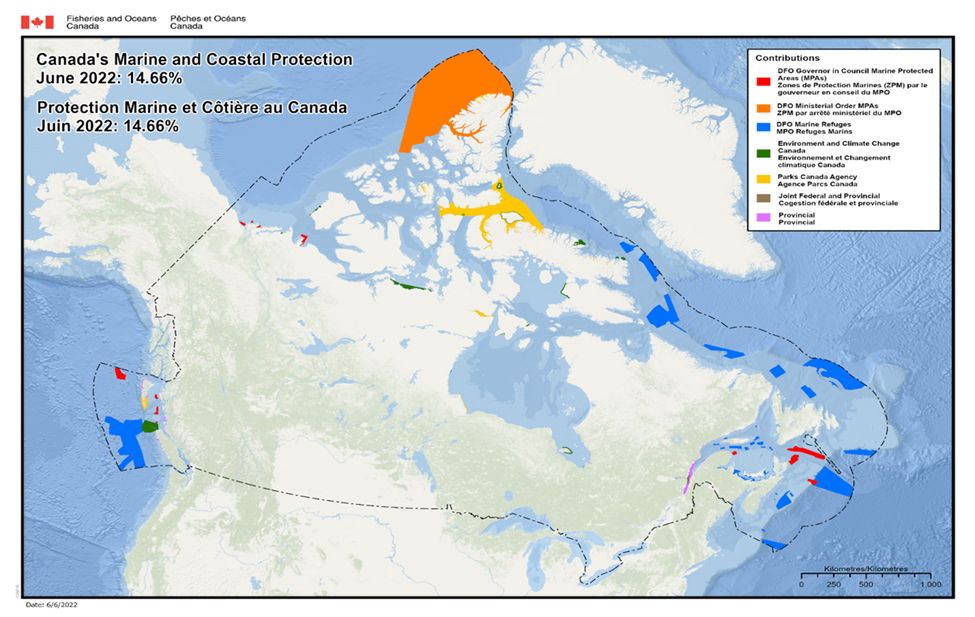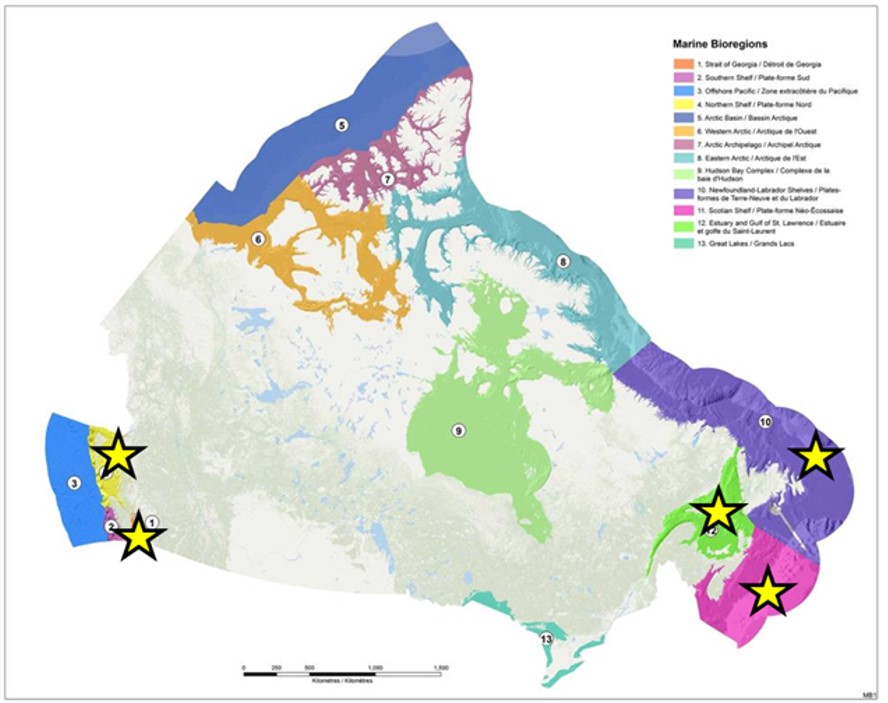Book 2, Tab C5 - Marine planning and conservation
On this page
- Purpose
- Marine conservation
- Marine conservation targets
- Marine conservation: Policy and process
- Marine environmental quality
- Marine spatial planning
- Decision making is informed by
- Annex A: Conserved areas
- Annex B: Legislative and regulatory tools for establishing conserved areas
- Annex C: Current MSP Planning Areas
Purpose
To provide an introductory overview of ministerial powers and responsibilities in three areas:
- Marine conservation
- Marine environmental quality
- Marine spatial planning
Marine conservation
The Minister has the power to establish marine protected areas, marine refuges, and ecologically significant areas
Summary
- Under the Oceans Act, the Minister recommends that the Governor-in-Council (GiC) establish marine protected areas (MPAs) through regulations.
- The Minister may also establish MPAs for up to five years through Ministerial Order (MO) regulations.
- Under the Fisheries Act, the Minister may establish:
- Marine refuges, which qualify as Other Effective Area-Based Conservation Measures (OECMs) and contribute to Canada’s marine conservation targets.
- Ecologically significant areas (ESAs) through regulations to protect sensitive, highly productive, rare or unique areas.
Definitions:
MPA: Part of the ocean that is legally protected and managed to achieve the long-term conservation of nature.
Marine Refuge: Part of the ocean (other than an MPA) which is governed and managed in ways that provide long-term biodiversity conservation benefits, for example by restricting certain kinds of fishing gear (e.g., gillnets) or practices (e.g., bottom trawling) as well as effectively avoiding or mitigating all other risks to the OECM. Marine refuges are a type of OECM.
ESA: Part of the ocean (or freshwater environments) where works, undertakings and activities are regulated based on conservation objectives for the area.
Marine conservation targets
Background and context
- In 2010, Canada committed to the marine conservation targets established under the United Nations Convention on Biological Diversity, which committed Canada to conserving 10 per cent of coastal and marine areas through 2020.
- In 2018, the G7 Charlevoix Blueprint for Healthy Oceans, Seas and Resilient Coastal Communities further committed Canada and other developed countries to supporting strategies to effectively protect and manage vulnerable areas of oceans and resources.
- In July 2020, Canada joined the Global Ocean Alliance, which is advocating to protect at least 30 per cent of the world’s oceans through the establishment of MPAs by 2030.
- The 10 per cent target was surpassed in August 2019.
- In December 2021, DFO Minister was asked to continue to work with Minister of Environment and Climate Change and partners to ensure Canada meets its goal to conserve 25 per cent of marine areas by 2025, and 30 per cent by 2030.
Work is advancing towards the international target of conserving 25% of marine areas by 2025, and 30% by 2030
Marine conservation: Policy and process
- The Oceans Act Marine Protected Area (MPA) establishment process can take between 7 and 10 years to complete.
- Allows for extensive information gathering and consultation to occur prior to the Minister’s approval and recommendation of the regulatory package to the GiC (i.e. Treasury Board) (Step 4).
- The Oceans Act enables MPA establishment using Ministerial Order regulations to protect vulnerable areas for up to five years while science and consultation continue to establish a long-term GiC MPA, another federal MPA, or another effective area-based conservation measures (OECM).
- The Government's 2019 MPA protection standard prohibits the following activities in all future federal MPAs:
- Oil and gas exploration and exploitation
- Mining
- Dumping
- Bottom Trawling
- Voluntary relinquishment of any existing oil and gas licences, in current MPAs will be sought. Should licences not be relinquished in these areas, the portion of the MPA that overlaps with the licence area would no longer contribute to meeting Canada’s international target.
- The Government's marine OECM protection standard, including marine refuges, requires that all risks to the site be effectively avoided or mitigated:
- An area in an OECM where oil and gas extraction under a production licence takes place will not be counted toward Canada’s international marine conservation target.
Oceans Act MPA establishment process
- Step 1: Selection of Area of Interest (AOI)
- Step 2: Ecological, Social, Cultural, and Economic overview and analysis
- Step 3: Development of the Regulatory Approach and consultation with interested/ affected parties
- Step 4: Regulatory Process & Designation of the MPA
- Step 5: MPA Management
Marine environmental quality
The Minister may establish marine environmental quality guidelines, objectives, criteria, standards and requirements
Summary
- Under the Oceans Act, the Minister may establish marine environmental quality (MEQ) guidelines, objectives, criteria, standards and requirements respecting estuaries, coastal waters and marine waters.
- These MEQ management measures are to be established in collaboration with partners, including provinces, territories, Indigenous peoples, and coastal communities.
- The non-regulatory tools (e.g., objectives, guidelines) may be established by DFO and regulatory measures (e.g., standards, requirements) are implemented by the GiC, on the recommendation of the Minister.
- These integrated and evidenced-based tools and strategies can be developed to: understand environmental stressors; evaluate existing management measures or strategies; and, adjust existing measures and/or develop new ones.
Specific commitments
- Release of a draft Ocean Noise Strategy and public consultation is expected in early 2023.
- The 2007 Statement of Canadian Practice with respect to the Mitigation of Seismic Sound in the Marine Environment is being reviewed and updated.
Marine spatial planning
The Oceans Act calls for the Minister of Fisheries and Oceans to “…lead and facilitate the development and implementation of plans for the integrated management of all activities or measures in or affecting estuaries, coastal waters and marine waters…”
Summary
- Marine Spatial Planning (MSP) is a pragmatic approach to implement integrated management that brings together relevant authorities and stakeholders to better coordinate how we use and manage marine spaces to achieve economic, ecological, social, and cultural objectives.
- MSP is an important tool in supporting oceans-related priorities, including:
- Providing a mechanism to support Canada's ocean economy
- Advancing collaborative relationships and governance structures with OGDs, Provinces, Territories and Indigenous peoples
- Enabling Canada to meet domestic and international commitments to marine conservation and protection
Quick fact
- MSP is currently underway in six marine areas (map at Annex C) building on past integrated oceans management planning efforts
- Four Marine Spatial Plans are to be developed by March 2024
Decision making is informed by
Science & Knowledge
Improve the collective understanding of oceans using integrated science and knowledge to support all processes (i.e., ecological and socio-economic data, Indigenous Knowledge, local stakeholder and community knowledge).
Standards
Minimum protection standards for federal MPAs and OECMs.
Socio-economic and cultural considerations
Analysis of impacts of conservation decisions on marine resource users, stakeholders, and coastal communities. Analysis of data on diverse ocean topics for MSP processes.
Partner collaboration and stakeholder engagement
Collaborative governance with OGDs, Provinces/Territories and Indigenous peoples.
Active participation of stakeholders (industry, environmental groups, and coastal communities).
Annex A: Conserved areas

Description:
Map of Canada’s marine and coastal protection. June 2022: 14.66%.
Contributions
- DFO governor in council marine protected areas (MPAs)
- DFO ministerial orders MPAs
- DFO marine refuges
- Environment and Climate Change Canada
- Parks Canada Agency
- Joint federal and provincial
- Provincial
Annex B: Legislative and regulatory tools for establishing conserved areas
Fisheries and Oceans Canada
- Oceans Act MPAs
- Fisheries Act ecologically significant areas
- Fisheries Act marine refuges
- Potentially additional OECMs
Environment and Climate Change Canada
- Marine National Wildlife Areas
- Marine portions of Migratory Bird Sanctuaries and National Wildlife Areas
Parks Canada Agency
- National Marine Conservation Areas
- marine portions of National Parks
Provinces and Territories
- Through their own legislative mechanisms
Indigenous Governments and Groups
- Potential for marine Indigenous Protected and Conserved Areas
Annex C: Current MSP Planning Areas
The planning areas shown here, (star), include;
- Pacific North Coast
- Pacific South Coast
- Bay of Fundy/Scotian Shelf
- Newfoundland-Labrador Shelves
- Estuary and Gulf of St. Lawrence

Description:
Marine bioregions
- Strait of Georgia
- Southern shelf
- Offshore pacific
- Northern shelf
- Artic basin
- Westshore artic
- Artic archipelago
- Eastern artic
- Hudson Bay complex
- Newfoundland-Labrador shelves
- Scotian shelf
- Estuary and Guld of St. Lawrence
- Great Lakes
- Date modified: